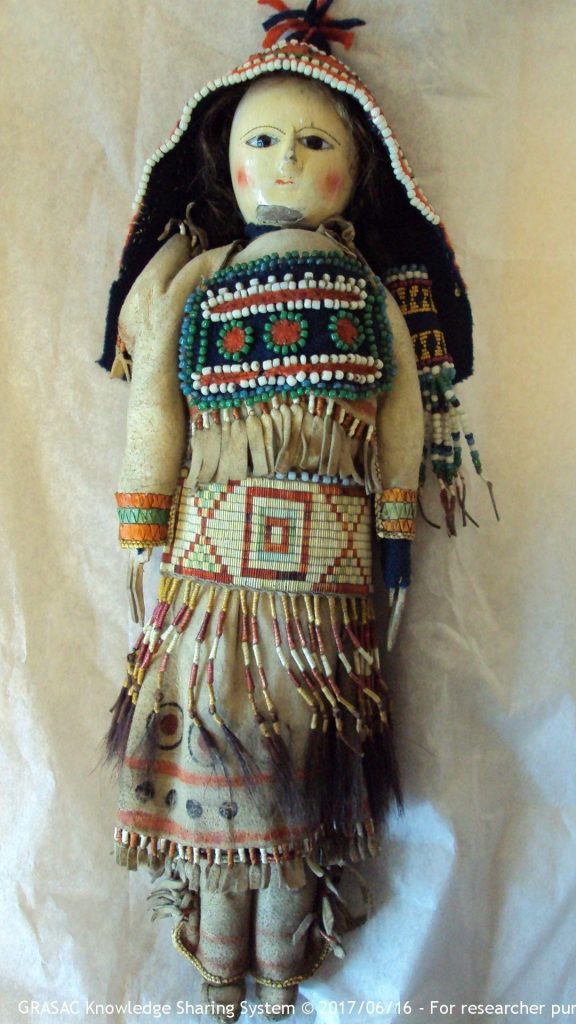by Sheila Wheesk, Swampy Cree, Taykwa Tagamou Nation, M.A. Student, Department of History, University of Toronto, and GRASAC Research Assistant, 2020-2021

It may come as a surprise to GRASAC members, but at present the GKS holds 150 records of heritage items labelled Cree. One beautiful example is this Maskekowiyiniwak (Swampy Cree) doll, currently housed in the Cuming Museum, in London, England (GKS ID 77).
Like other dolls described by Cath Oberholzter, in “All Dolled Up: The Encapsulated Past of Cree Dolls,” this doll is a stunning example of Maskekowiyiniwak artistry (Oberholtzer 1998).
This doll is Maskekowiyiniwak (Swampy Cree) and was likely made for personal use or as a gift. The Swampy Cree are a large nation that extends across northern Manitoba, northern Ontario and the coastal area around James Bay. This doll was likely from York Factory, writes Sherry Farrell-Racette. The doll’s head is constructed from wood and it is made in the Queen Anne style. The dress is made of hide. The belt is made up of porcupine quills. Also, quills are found wrapped around the tassels. On the bottom of the leggings are braided woollen cords sewn along the cuff. The beads on this doll range in size from 15 to size 10 or 11. Beads are found on the hood and yoke. The beads on the hair ties are the much smaller 15s. The use of negative space on the tassels create the diamond pattern. Other dolls of this period also have a cape which is typical of how the Cree dressed at the time this doll was made.
What is most remarkable about the Cree doll is the technique on the clothing of the doll. The dress, yoke, hood and leggings reflect how the Maskekowiyiniwak women dressed during the 18th century. The skills used in the making of the doll show the women’s ingenuity because they were able to combine European materials such as wooden doll heads, beads and fabric with materials collected and prepared from their own environment, such as hide, hair from an animal, and porcupine quills. This doll may be used as a window to the past as the doll is representative of the fashion these women may have worn at the time. The construction of the clothes of the doll may also be typical of the materials and the techniques the women used. The doll is a testament to the Maskekowiyiniwak women’s superior artistic technique.
As a personal reflection, what is most significant to me is the design found on the bib of the doll. Here the beaded design is rounded, not squared and oriented in an east/west configuration with three small beaded circles centred between two elongated areas above and below. A lodge is configured similarly. It is an elongated structure with its ends oriented in the same east/west configuration with fires positioned down the middle of the lodge where the men sit on one side of the lodge and the women sit on the other. Although the Mide may not have extended as far north at the time this doll was made, the design may indicate that the doll’s maker may have had knowledge of ceremony and may have chosen to represent this knowledge with the doll.
Works Cited:
Oberholtzer, Cath. 1998. “All Dolled Up: The Encapsulated Past of Cree Dolls.”Papers of the Twenty-Ninth Algonquian Conference. Winnipeg: Univerity of Manitoba. 225-242.
Farrell-Racette, Sherry. 2020. “Re: From the GKS_A Cree Doll-thoughts and queries?” Email Regina: University of Regina. 27 Nov 2020.
